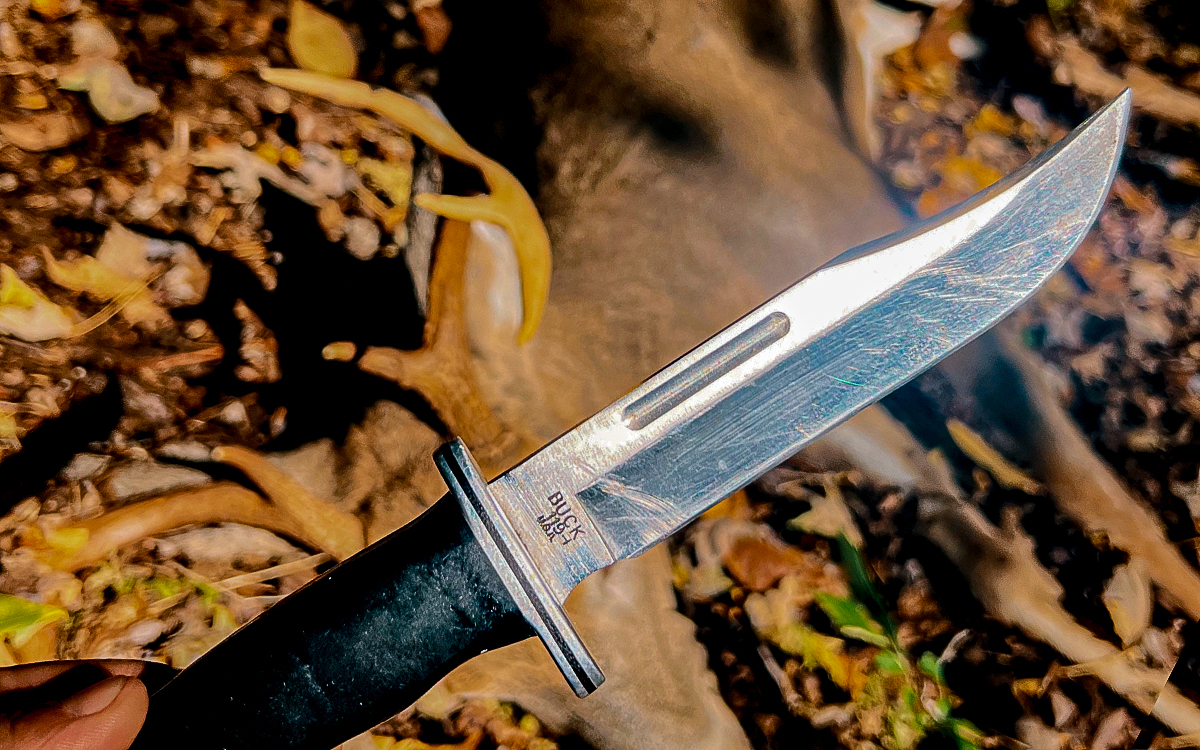A few weeks ago, I broke out my sharpener and got my Buck knife ready for another long season. This is an annual ritual, and each year I take a moment to admire the wear and tear the blade and handle had seen. Each little blemish tells its own story, and for this knife, it holds every story of my hunting career.
I received this knife when I began hunting which, here in Pennsylvania, kicked off when I was 12 years old. Back then, the knife was new, shiny, and sharper than I could ever get it to be now. But more important than the aesthetics of the knife was its potential. I had no idea what it would help me accomplish in the next 17 hunting seasons.
I know that large, fixed blade knives like this one are not trendy in the hunting world. Everyone seems to be moving to smaller blades with fancier steels or ultra-light and ultra-sharp replaceable-blade knives. But the truth is, you don’t need an expensive precision instrument to gut a deer. For me, it’s a lot more meaningful to use a knife that has so many good memories scratched into than a new high-end blade.
And that, among a few other reasons, is why I believe the Buck knife will live forever.
The History of the Buck Knife
In 1902 Hoyt Buck, a 13-year-old blacksmith’s apprentice in Kansas, was experimenting with ways to temper steel so it would keep an edge for longer. He was, of course, successful in his experiment, although the Buck knife didn’t show up in the market for years after Buck’s discovery.
In 1947, Hoyt and his son Alfred set up a shop called H.H. Buck & Son behind their home. The father and son duo continued to make high-quality hand made knives and their business took off. In fact, Hoyt Buck made approximately 25 knives by hand each week until his death in 1949.
Alfred Buck then took over where his father left off. In the early 50s, he expanded advertising of Buck knives to mail order catalogs. In 1961, Buck was incorporated and in 1964, the company introduced the Model 110 Folding Hunter knife, which became one of the most popular knives ever made. In 1992, Buck debuted the Nighthawk, a fixed-blade knife that was 6.5 inches and had a black handle made of Zytel for an ergonomic grip. This knife was submitted to the U.S. Navy for evaluation for use by Navy Seals.
With over 100 years of blacksmithing and knife work under the Buck name’s belt, it’s no wonder why they’re still one of the most popular knife producers to this day.
Traditional Buck Knife Specs and Features
While my Buck knife isn’t the original Model 110 Folding Hunter, it still carries a traditional feel to it. My Buck 119 Special fixed blade knife has some quality components, and admittedly does leave some room for improvements too.
The 6-inch blade is made from 420HC steel and is clipped into a phenolic handle. In total, the knife weighs 7.5 ounces. It’s heavy, bulky, and not always easy to maneuver, but it sure does work. It’s great for that first cut while field dressing a deer because the tip curves, allowing my hand to drop down lower than the tip to avoid puncturing the stomach or other intestines during the process.
Where it seems to fall short in comparison to newer, fancier knives are the close-quarters work above the diaphragm when removing the heart and lungs. The large blade is often difficult to twist and turn in the tight space, leading to a few accidental knicks to my fingers from time to time.
When I compared it with a new Montana Knife Company Whitetail knife, I was able to see just how much more convenient it is to have a smaller, 4” blade for maneuverability in the body cavity. I’ll be doing a full side-by-side comparison between the two knives in the coming weeks, so more on that later.
The Blade I’ve Shared Every Hunt With
I’m not sure if it’s because I’m getting older or what, but recalling all of the memories this knife and I have shared really hit home this year. We’ve come a long way together This knife has been there for all of the “firsts” in my hunting career: My first deer, first buck, first turkey, and even my first bear. It’s been on out-of-state hunts, out-of-country hunts, and even got lost in the prairie of South Dakota for a day or two after it gutted my first mule deer.
Sometimes it’s so dull from running into bone that it couldn’t cut a piece of paper, while other times, I’ve kept the edge so keen it’s like running a knife through butter. It hasn’t lived a glamorous life, but it’s been there for each of the moments I truly live for.
After chatting with OL’s executive gear editor Scott Einsmann and realizing that many hunters don’t have the same knife they started with, I called my Dad to tell him we might just be a tad weird. You see, I can’t claim that I’m the one who started this “same knife forever” trend. My Dad has been running the same gutting knife in his deer hunting pack for over 43 years.

After running my Buck knife through the WorkSharp a few times, I felt the edge to make sure it was ready for another year being lugged around the deer woods with me. There are, admittedly, a few burrs that I need to address if I want it to be perfect, but it’s good enough for me. The knife may not be perfect, but it’s perfect for me.
I packed it away in its black sheath and tucked it into my hunting pack, hoping it would see the light of day in a few short weeks. As luck would have it, opening week was quite successful, and the knife gutted a doe for me, and a first archery buck for a close friend. After a quick rinse and another few rounds in the WorkSharp, it’s right back where it belongs, in my pack, ready for our next adventure.
Read the full article here




